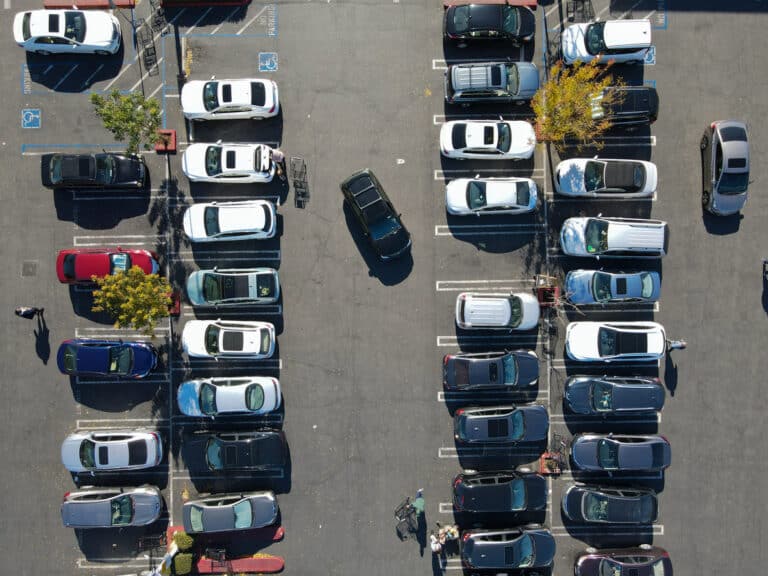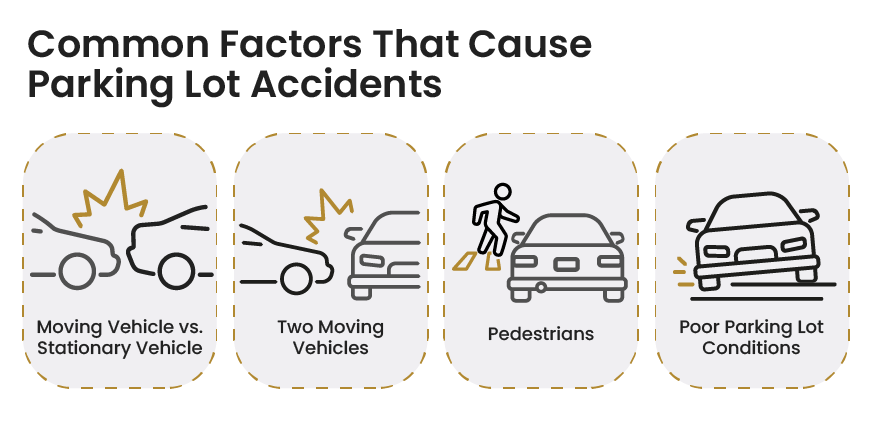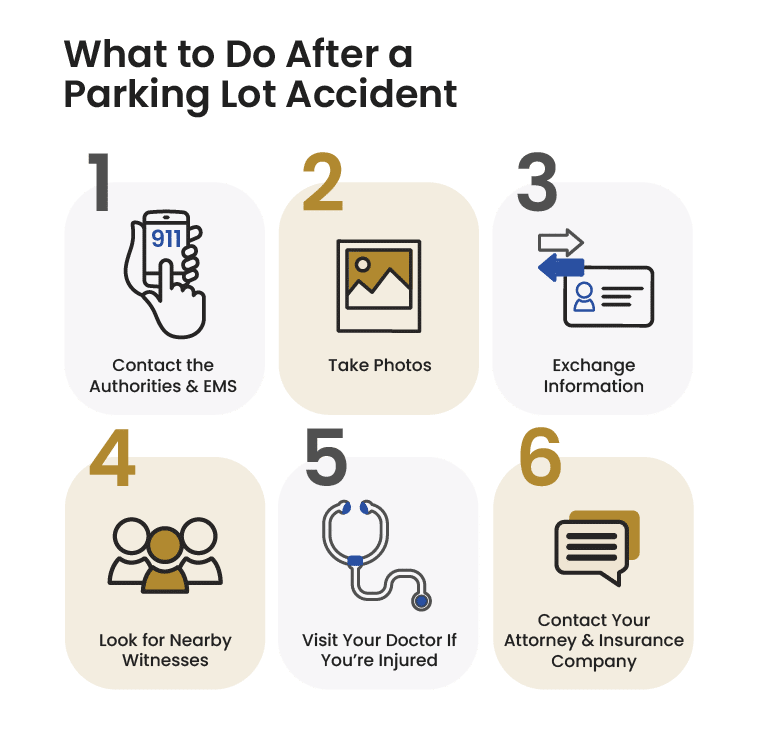A Guide on What to Do After a Parking Lot Car Accident
Category: Car Accidents
Article by Aaron F. Tuley

Parking lots are full of distraction, poor visibility, uncertainty of who has the right-of-way, and frustration if you can’t quickly drive in and out. It’s an environment primed for car accidents.
These scenarios are more common than you think. The National Safety Council conducted a study that found nearly 60,000 injuries and 500 deaths each year due to parking lot crashes. Parking lot accidents can involve moving and stationary vehicles and pedestrians. It can be hard to figure out who’s at fault in these accidents because the responsibility isn’t always clear.
This comprehensive guide aims to shed light on the complexities surrounding parking lot accidents, their legal implications, and the process of claiming compensation.
What are Common Types of Parking Lot Accidents
Parking lot accidents can take many forms. Its circumstances determine who might be at fault and what steps to take next.
Let’s discuss some typical scenarios:
Moving Vehicle vs. Stationary Vehicle
A common parking lot accident involves a moving vehicle colliding with a stationary one. Often, this is due to a driver failing to notice a parked car or misjudging the space while parking or exiting. In most cases, the driver of the moving vehicle is typically held responsible for the accident.
Two Moving Vehicles
Accidents can also occur between two moving vehicles in a parking lot. These incidents often happen at intersections within the parking lot or when both cars are vying for the same spot. Determining fault in these situations often depends on the right-of-way rules and the unique circumstances of the accident.
Accidents Involving Pedestrians
Not only are parking lots full of cars, but they also see many pedestrians walking to and from their vehicles. Accidents can happen when a driver, either backing out of a parking spot or driving through it, overlooks a pedestrian. In most cases, the driver is liable for accidents involving pedestrians. Still, the pedestrian’s actions during the accident could also influence the determination of fault.
Accidents Due to Poor Parking Lot Conditions
Sometimes, the condition of the parking lot itself can contribute to accidents. Suppose the parking lot has inadequate signage, insufficient lighting, or surfaces needing maintenance. In that case, the owner may be partly liable for accidents due to these hazardous conditions. Each scenario presents a different set of challenges when determining fault and seeking compensation.
In the following sections, we will delve deeper into the rules of right-of-way in parking lots, the role of insurance companies in investigating accidents, and the concept of shared responsibility in Indiana.
Understanding Right of Way in Parking Lots
The “right of way” concept is critical in determining who is at fault in a parking lot accident. But, unlike public roads, where traffic laws are clear, it can be more ambiguous in parking lots.
Here are some general guidelines that often apply:
Two Vehicles Backing Out
In a situation where two vehicles simultaneously back out of their parking spaces and collide, both drivers may share the fault. This is because neither driver had the right of way. In addition, both were responsible for ensuring it was safe to proceed. However, one driver may still be more at fault than another. For example, if someone backs out almost entirely and another person reverses without checking their mirrors.
One Vehicle Backing Out Into a Lane
If a vehicle backs out of a parking space and collides with a car moving in the lane, the driver leaving the parking space is generally liable. The driver in the lane has the right of way, and the driver leaving the parking space must yield.
Vehicles Vying for the Same Spot
In situations where two drivers attempt to park in the same spot simultaneously, both may share some degree of responsibility. However, a driver making a left turn into the spot may bear a larger share of the fault for failing to yield to the driver making a right turn.
Pedestrians
Pedestrians generally have the right of way in parking lots. Drivers should yield to pedestrians walking in marked crosswalks and on sidewalks. However, pedestrians are also responsible for acting safely and not stepping out unexpectedly into the path of moving vehicles.
Primary Lanes
People driving in the primary lanes running through or around the parking lot generally have the right of way. So, if you are trying to turn into one of these lanes from a parking spot or a secondary lane, you should yield to the vehicles in the primary lane.
Rear-End Collisions
These accidents occur when a driver hits the vehicle in front of them. Rear-end accidents happen due to sudden stops, distractions, or failure to maintain a safe distance. In most cases, the driver who rear-ends the other vehicle is at fault as they should leave enough space to stop safely, even if the car in front stops unexpectedly. But, there could be exceptions, such as if the front vehicle reverses or the brake lights malfunction.
How Car Insurance Companies Investigate Parking Lot Accidents
In most circumstances, the insurance company will investigate the accident.
Here’s what that process typically looks like:
- Collecting evidence: This includes photographs of the accident scene, vehicle damage, any visible injuries, and the surrounding area. It may also involve gathering available surveillance footage from the parking lot and statements from the drivers and witnesses.
- Examining the damage: The location and extent of the damage can often provide clues about how the accident occurred and who is likely at fault.
- Considering local traffic laws: The adjuster will consider local traffic laws, including right-of-way rules, to help determine who was at fault. Sometimes, they may consult traffic law experts or accident reconstruction specialists.
- Final decision: Finally, based on all the collected information, the adjuster will decide who was at fault, informing their decision on how much the insurance company is liable to pay in damages.
Most people associate lawyers with courtrooms, but many cases involving car wrecks never make it to a courtroom. Instead, all the negotiation happens with and between insurance companies. Insurance companies aim to minimize the amount they pay you.
The main benefit of working with an experienced Evansville car accident lawyer at Tuley Law is that we will advocate for you and ensure you get the settlement you deserve. We’ll conduct an independent investigation, build a case, and help you navigate the insurance claim efficiently.
Shared Responsibility in Indiana
In some parking lot accident scenarios, the fault may not rest solely with one party. Instead, both parties may share some degree of responsibility for the incident. This is known as comparative fault, and it plays a significant role in personal injury law in Indiana.
Under Indiana’s comparative fault law, an injured party can recover damages even if they are partially at fault for the accident. However, the percentage of their fault will reduce their compensation. For example, if a parking lot accident finds you 20% at fault because your brake lights weren’t functioning, your awarded damages will reflect a 20% reduction. So if the court awards you $5,000 in damages, you’ll receive $4,000 instead.
What to Do After a Parking Lot Accident
Your immediate actions are crucial if you’re involved in a parking lot accident. The steps you take following the incident greatly influence your future case.
Step 1: Contact the Authorities and EMS
You should contact EMS for the necessary treatment if anyone involved is injured. Don’t let adrenaline make you overlook your injuries; take a deep breath and see if you feel any pain. Next, if property damage exceeds $1,000, you should contact the police to make a report.
Although most drivers in parking lots move at slower speeds, and damage might be minor, always inspect your car closely. If you’re not sure about the extent of the damage, contact the authorities anyway. It’s often better to have a police report for your insurance claim.
You should also contact the police if the wreck is a risk to other drivers or if it was a hit-and-run accident.
Step 2: Take Photos
In a rush to clear a traffic lane, you might think to move your car immediately out of the way after an accident. But, you shouldn’t do this. Instead, take detailed photos of the wreck as it happened. You’ll want images of both vehicles and any nearby signage from multiple angles. These images are a critical component of your insurance claim.
Step 3: Exchange Information
You’ll need to obtain insurance information from the other driver. They should either have a paper copy in the car or a digital copy on their phone. You’ll need the company’s name, policy number, policyholder’s name, contact information, and vehicle information (make, model, color, and license plate number).
Step 4: Look for Nearby Witnesses
See if anyone witnessed the wreck, and ask if you can have their contact information and if they’d be willing to provide their statement if requested.
Step 5: Visit Your Doctor If You’re Injured
Even if you don’t feel pain immediately following the accident, you might still have an injury, such as whiplash, that you don’t feel until after your adrenaline wears off. You’ll want to schedule a doctor’s appointment as soon as possible to get checked out.
Step 6: Contact Your Attorney and Insurance Company
You’ll need to report the accident as soon as possible. Some insurance companies require you to report a claim within 24 to 72 hours, but it all depends on the policy. You’ll want an attorney to assist with your claim to avoid any errors affecting your entitled settlement.
Trust Your Case to the Experts at Tuley Law
If you or a loved one is injured in a parking lot accident in Indiana, Tuley Law can help. Our experienced car accident and injury lawyers are skilled in accident investigation, interpretation of insurance policies, and negotiating with insurance companies. We’ll make sure you get the compensation you deserve.
Contact us today for a free consultation.
Have questions about your case?
Contact us


